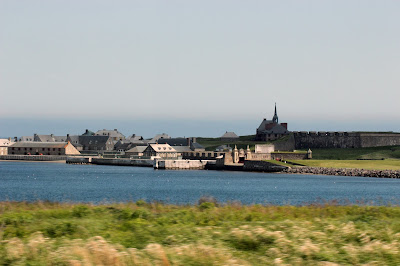We arrived at North Sidney late during the day and we had dinner at Governor's Pub where I finally ordered my Lobster dinner. It tasted close to a crab, so I can admit that I enjoyed it a lot, and I did not even care about butter. To my husband disappointment I did not use the provided bib. It is a tradition he said.
Next day we got up early to head to Cape Breton highlands and the Cabot Trail.
Our first encounter with the highlands of Cape Breton was Kelly's Mountain, before we even reached the Cabot Trail.
Next day we got up early to head to Cape Breton highlands and the Cabot Trail.
Our first encounter with the highlands of Cape Breton was Kelly's Mountain, before we even reached the Cabot Trail.
Picture courtesy of Google
We decided not to take the Englishtown ferry, it would have taken longer to get to the Cabot Trail. The ferry is very small and there was probably a number of cars waiting to be taken across.
I think we stopped at every lookout point along the way.
We stopped for lunch at a Seagull Restaurant in a town almost in the Cape Breton Highlands National Park. It was nice to see locals eating there, and the food proved to be very good.
We also saw rain coming in, but it never really caught up with us. When we turned around the mountain, it was nice and sunny again.
When we drove across to the other side of the island we stopped at the North Highlands Community Museum where we learned the North Highlands history and the tragic end of The Auguste; the ship that was carrying exiles from the fall of New France.
On the way we stopped at a small trail "The Lone Shieling" when we were greeted by a Coyote Habitat sign. We found two big walking sticks just in case and walked onwards. An exhibit on the trial tells the story of why it's here in our highlands and what it was used for in the highlands of Scotland.
We found that the green ferns and trees were overwhelming and beautiful. No Coyotes were spotted.
At the end we found that there were a lot of walking sticks at the end of the trail used by previous visitors. We decided to leave our sticks at the beginning of the trail for future visitors to find.
We also stopped at "Bog". It is a self guiding trail with signs that explain life there – pitcher plants, delicate orchids, colourful dragonflies, green frogs and gigantic moose.
It is here at Bog we found a mama moose and baby moose.
We enjoyed the rest of scenery and the Cape Breton Low lands, and on the way back we stopped at Baddeck Lobster Suppers for a fire cooked planked salmon.
The next day we spent at the Fortress of Louisbourg where we learned about the history of 18th century New France. By the mid-1740s Louisbourg was one of the most extensive (and expensive) European fortifications constructed in North America. The reconstruction is about a quarter of what it was at the time of its height. It used to provide housing and work for 30,000 people, merchants, military, fishermen and nobility. https://en.wikipedia.org/wiki/Fortress_of_Louisbourg
The highlights was a stop for an authentic lunch at the Hotel and hot chocolate, just as they made it back then. (Chocolate was a medicine back then, and it was very expensive)
The fortress also provides a fantastic view of the Louisbourg lighthouse.
Before heading out we stopped by a pen to say hi to the sheep of the fortress, and we were surprised by being greeted by the local goat.
For the dinner we finally were able to try the local restaurant in North Sydney: The Black Spoon.






















Comments
Post a Comment